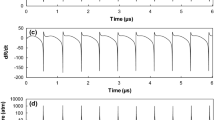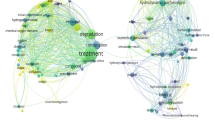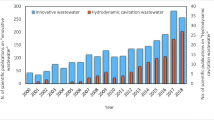Abstract
We present an experimental study on hydrodynamic cavitation generated by accelerating liquid through a series of constrictions in the presence of gas bubbles and explore its possible applications in water treatment with particular example in aquaculture industry. The formation of intense cavitation bubbles is visualized using a high-speed photography. The cavitation is initiated when a gas bubble moves towards a narrow cylindrical constriction where it accelerates, expands and then splits into smaller bubbles owing to the sharp pressure gradient of the liquid flow inside the constriction section. As the bubbles emerge downstream from the constrictions, they are exposed to a higher pressure region and collapse violently forming a cloud of bubbles. Smaller and more dispersed bubbles are produced by further passing the bubbles through a second series of constrictions. By introducing gas bubbles that serve as cavitation nuclei prior to the constriction, it is unnecessary to force the liquid flow below its vapor pressure to produce intense cavitation, thus enhancing the cavitation activities. We also present experimental evidences of a significant reduction of gram-negative Escherichia coli concentration after exposing them to the cavitation bubbles. Yet, the cavitation bubbles are found to be not sufficiently strong to lyse endospores Bacillus subtilis that are widely used in aquacultures.
Graphic abstract







Similar content being viewed by others
References
Ando K, Liu AQ, Ohl CD (2012) Homogeneous nucleation in water in microfluidic channels. Phys Rev Lett 109:044501
Badve M, Gogate P, Pandit A, Csoka L (2013) Hydrodynamic cavitation as a novel approach for wastewater treatment in wood finishing industry. Sep Purif Technol 106:15–21
Blake JR, Gibson DC (1987) Cavitation bubbles near boundaries. Ann Rev Fluid Mech 19:99–123
Braeutigam P, Franke M, Schneider RJ, Lehmann A, Stolle A, Ondruschka B (2012) Degradation of carbamazepine in environmentally relevant concentrations in water by hydrodynamic-acoustic-cavitation (HAC). Water Res 46:2469–2477
Chakinala AG, Gogate PR, Burgess AE, Bremner DH (2009) Industrial wastewater treatment using hydrodynamic cavitation and heterogeneous advanced Fenton processing. Chem Eng J 152:498–502
Dean WR (1927) XVI. Note on the motion of fluid in a curved pipe. Lond Edinb Dublin Philos Mag J Sci 4:208–223
Dennis SCR, Ng M (1982) Dual solutions for steady laminar flow through a curved tube. Q J Mech Appl Math 35:305–324
Ding Z, Gracewski SM (1996) The behaviour of a gas cavity impacted by a weak or strong shock wave. J Fluid Mech 309:183–209
Ghayal D, Pandit AB, Rathod VK (2013) Optimization of biodiesel production in a hydrodynamic cavitation reactor using used frying oil. Ultrason Sonochem 20:322–328
Gogate PR (2011) Hydrodynamic cavitation for food and water processing. Food Bioprocess Tech 4:996–1011
Gogate PR, Pandit AB (2001) Hydrodynamic cavitation reactors: a state of the art review. Rev Chem Eng 17:1–85
Gogate PR, Shaha S, Csoka L (2014) Intensification of cavitational activity in the sonochemical reactors using gaseous additives. Chem Eng J 239:364–372
Jyoti KK, Pandit AB (2001) Water disinfection by acoustic and hydrodynamic cavitation. Biochem Eng J 7:201–212
Krishnan JS, Dwivedi P, Moholkar VS (2006) Numerical investigation into the chemistry induced by hydrodynamic cavitation. Ind Eng Chem Res 45:1493–1504
Kumar P, Khanna S, Moholkar VS (2012) Flow regime maps and optimization thereby of hydrodynamic cavitation reactors. AIChE J 58:3858–3866
Leighton T (1994) The acoustic bubble. Academic press, London
Li P, Song Y, Yu S (2014) Removal of microcystis aeruginosa using hydrodynamic cavitation: performance and mechanisms. Water Res 62:241–248
Martin CS, Medlarz H, Wiggert DC, Brennen C (1981) Cavitation inception in spool valves. J Fluids Eng 103:564–575
Miller S (1993) Disinfection products in water treatment. Environ Sci Tech 27:2292–2294
Moholkar VS, Pandit AB (2001) Modeling of hydrodynamic cavitation reactors: a unified approach. Chem Eng Sci 56:6295–6302
Osman H, Lim F, Lucas M, Balasubramaniam P (2016) Development of an ultrasonic resonator for ballast water disinfection. Phys Proc 87:99–104
Philipp A, Lauterborn W (1998) Cavitation erosion by single laser-produced bubbles. J Fluid Mech 361:75–116
Rahn O (1945) Physical methods of sterilization of microorganisms. Bacteriol Rev 9:1–47
Save SS, Pandit AB, Joshi JB (1994) Microbial cell disruption: role of cavitation. Chem Eng J Biochem Eng J 55:B67–B72
Seneviratne PN (2005) Device for treating aqueous liquids. US Pat Appl 11(908):938
Shibata S, Nishio S, Sou A, Akayama D, Mashida M (2015) Evaluation of cavitation in injector nozzle and correlation with liquid atomization. J Vis 18(3):481–492
Suslick KS, Flannigan DJ (2008) Inside a collapsing bubble: sonoluminescence and the conditions during cavitation. Annu Rev Phys Chem 59:659–683
Suslick KS, Mdleleni MM, Ries JT (1997) Chemistry induced by hydrodynamic cavitation. J Am Chem Soc 119:9303–9304
Tandiono T, Klaseboer E, Ohl SW, Ow DSW, Choo ABH, Li F, Ohl CD (2013) Resonant stretching of cells and other elastic objects from transient cavitation. Soft Matter 9:8687–8696
Tandiono T, Ohl SW, Ow DSW, Klaseboer E, Wong VV, Camattari A, Ohl CD (2010) Creation of cavitation activity in a microfluidic device through acoustically driven capillary waves. Lab Chip 10:1848–1855
Tandiono T, Ohl SW, Ow DSW, Klaseboer E, Wong VV, Dumke R, Ohl CD (2011) Sonochemistry and sonoluminescence in microfluidics. Proc Natl Acad Sci USA 108:5996–5998
Tandiono T, Ow DSW, Driessen L, Chin CSH, Klaseboer E, Choo ABH, Ohl SW, Ohl CD (2012) Sonolysis of Escherichia coli and Pichia pastoris in microfluidics. Lab Chip 12:780–786
Tsolaki E, Diamadopoulos E (2010) Technologies for ballast water treatment: a review. J Chem Tech Biotech 85:19–32
Turangan CK, Ball GJ, Jamaluddin AR, Leighton TG (2017) Numerical studies of cavitation erosion on an elastic–plastic material caused by shock-induced bubble collapse. Proc R Soc A Math Phys Eng Sci 473(2205):20170315
Turangan CK, Jamaluddin AR, Ball GJ, Leighton TG (2008) Free-Lagrange simulations of the expansion and jetting collapse of air bubbles in water. J Fluid Mech 598:1–25
Vaidya HA, Ertunç Ö, Lichtenegger T, Hachmann J, Delgado A, Skupin A (2017) High-speed visualization of acoustically excited cavitation bubbles in a cluster near a rigid boundary. J Vis 20(2):359–368
Xu R, Jiang R, Wang J, Liu B, Gao J, Wang B, Han G, Zhang X (2010) A novel method treating organic wastewater: air-bubble cavitation passing small glass balls. Chem Eng J 164:23–28
Zheng Q, Durben DJ, Wolf GH, Angell CA (1991) Liquids at large negative pressures: water at the homogeneous nucleation limit. Science 254:829–832
Acknowledgements
The authors are grateful to Professor Claus-Dieter Ohl and Dr. Siew Wan Ohl for their assistance and discussion during the experiment.
Author information
Authors and Affiliations
Corresponding author
Additional information
Publisher's Note
Springer Nature remains neutral with regard to jurisdictional claims in published maps and institutional affiliations.
Electronic supplementary material
Below is the link to the electronic supplementary material.
Supplementary file1 (AVI 1929 kb)
Supplementary file2 (AVI 500 kb)
Rights and permissions
About this article
Cite this article
Tandiono, T., Kang, C.W., Lu, X. et al. An experimental study of gas nuclei-assisted hydrodynamic cavitation for aquaculture water treatment. J Vis 23, 863–872 (2020). https://doi.org/10.1007/s12650-020-00668-5
Received:
Revised:
Accepted:
Published:
Issue Date:
DOI: https://doi.org/10.1007/s12650-020-00668-5




